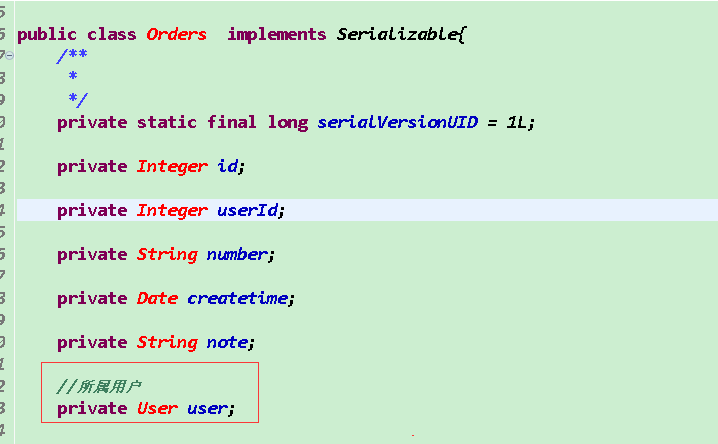这里说的一对一和一对多指的是某一方为中心来看待的
一.一对一映射
1.给order类添加一个属性对象user,如图:

2.现在比如查询全部有所属客户的订单,在映射文件配置如下:
<!-- 除普通属性外,映射到属性对象中的属性 -->
<resultMap type="Orders" id="orderList">
<id property="id" column="id"/>
<result property="userId" column="user_id"/>
<association property="user" javaType="User">
<id column="id" property="id" />
<result property="username" column="username"/>
</association>
</resultMap>
<!-- 查询所有订单 -->
<select id="findOrderList" resultMap="orderList">
select o.id, o.user_id, u.id, u.username
from orders o,user u
where o.user_id = u.id
</select>
说一下,如果映射的对象A中的属性是对象B,则B里面的属性不会被映射到,需要手动映射,association表示一对一映射;
再强调两点:
>如果添加了association,如果想要将返回的结果集统一映射到每个属性上,就要指定想映射的属性,即使属性名和列名一致也不会自动映射
>查询到的结果集避免出现不同表的相同主键名,这会导致是有一列无效的,就上述的代码就是个典型的示范,orders的主键列为id,user表的主键列还是id,如果返回的结果集包含这两列,靠后的一列是无效的
二.一对多映射
<resultMap type="User" id="userList">
<id property="id" column="id"/>
<result property="username" column="username"/>
<collection property="orders" ofType="Orders">
<result property="number" column="number"/>
</collection>
</resultMap>
1.一对多映射跟一对一的操作差不多,不过有一些小区别,colleaction用于一对多情况,ofType代表集合的泛型